Thanks for sharing the info, keep up the good work going on.I really enjoyed exploring your site and indeed good resource.
Information you share is very useful. It is closely related to my work and has helped me grow. Thank you!
Healthy Heart
How to Fix All Your Sleep Problems With Science
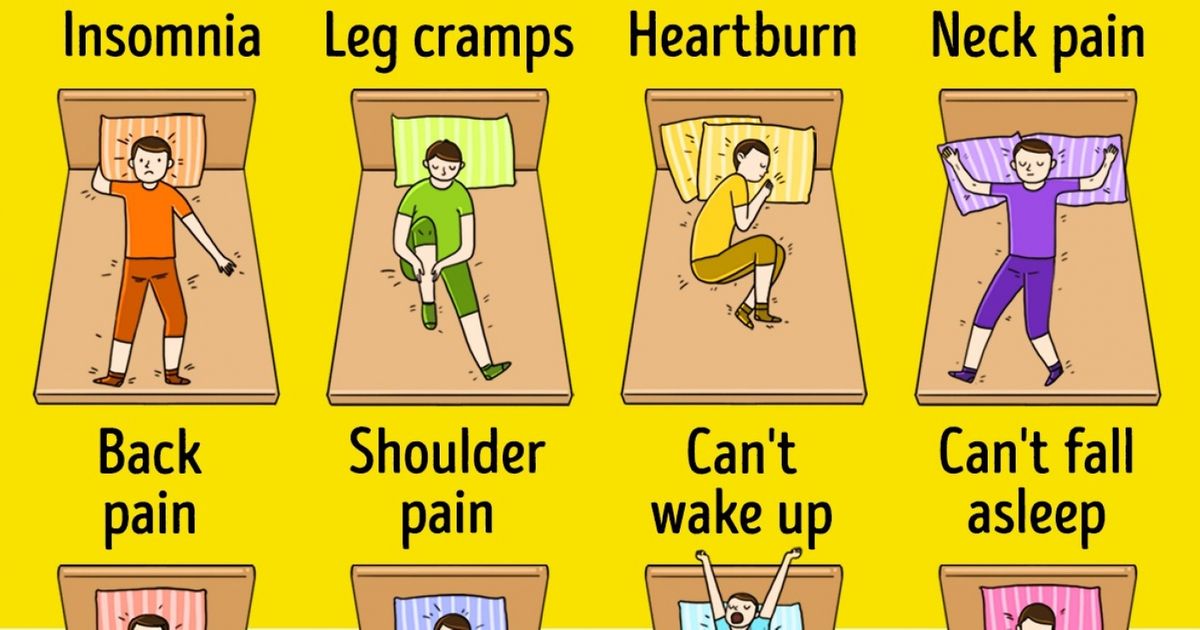
We spend about a third of our life sleeping. Both the quality of our night’s rest and our overall health depend directly on our sleep posture and on what we do before going to bed.
We at Bright Side have put together recommendations from top specialists on how to sleep properly to fix all of your health problems.
Shoulder pain

If you wake up with a sore shoulder, avoid sleeping on your side, especially on the painful shoulder. It is also not advised to sleep on your stomach since it causes misalignment of the shoulders.
The best sleeping posture is lying on your back. Put a thin pillow (an orthopedic one will work best for you) under your head. Take another pillow, place it on your stomach, and hug it. Your shoulders will now be in the correct and stable position.
If you don’t like sleeping on your back, try lying on the side that is not painful. Draw your legs up slightly toward your chest, and place a pillow between your knees. Sleeping with your hand under your head is not advisable since it produces an unnatural positioning of the shoulder.
Back pain
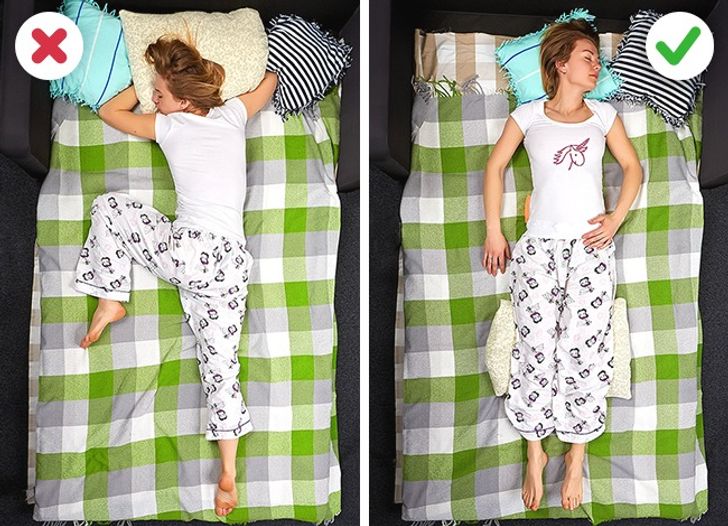
If you have back pain, maintaining the normal curvature of your spine is very important. If your mattress is overly soft, it’s time to get a new one.
Sleeping on your back is probably the best position for you. Place a pillow under your knees to help restore natural spinal curves and reduce the tension in your tendons. You might also try a small rolled towel under your lower back for additional support.
If you’re a stomach sleeper, put a pillow under your lower abdomen and pelvis so that the small of your back doesn’t move forward.
If you like sleeping on your side, then it’s best to take the fetal position. Draw your legs up slightly toward your chest, keeping your back naturally arched. Put a small pillow between your knees. This can help you take the load off your lower back.
Neck pain
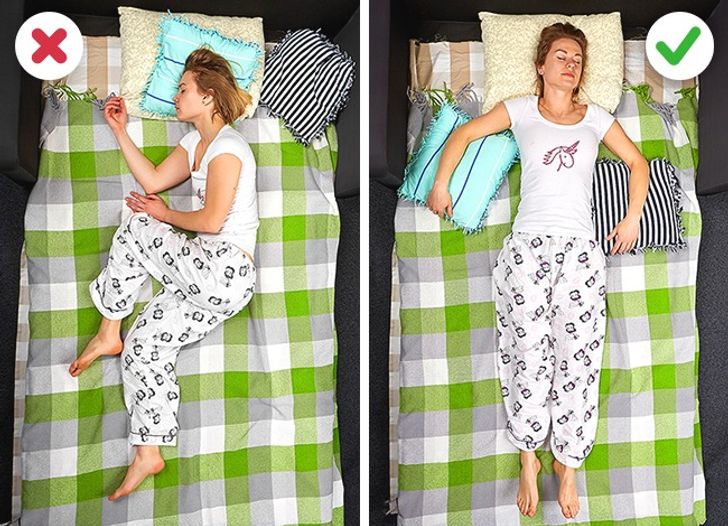
Just like with back pain, your neck needs to be supported while you sleep.
In general, sleeping on your back with a pillow under your head and a pillow under each arm is the best option. People with neck problems should choose their pillows very carefully, and it’s best to go for orthopedic or roll pillows.
If you prefer to sleep on your side, make sure your pillow is not too high. It shouldn’t be thicker than 6 inches. Ideally, the height of your pillow should match the width of one shoulder to help keep your neck in the correct position.
If you’re a stomach sleeper, use the thinnest pillow you can find. It’s better not to sleep in this position at all since lying all night with your head turned to one side will strain your neck.
Can’t fall asleep

It can be tough to banish phones and computers before bedtime, but you should. It really helps if you have trouble falling asleep. The light from screens affects our sleep-wake cycles.
Avoid consuming caffeine — coffee, energy drinks, soda, black tea, and chocolate — for at least 6 hours before going to bed.
Exercise in the morning and afternoon. This helps to tone your whole body, improve your blood circulation, and helps you to fall asleep much faster.
Can’t stay asleep

If you often wake up in the middle of the night, you should not only avoid using any gadgets before going to sleep but also any alcohol before bedtime. Alcohol disrupts the water balance in your body and affects your sleep cycle.
Moreover, check your room temperature. The ideal sleeping temperature is 68°F to 71°F (20°C to 22°С).
Can’t wake up

Snoring
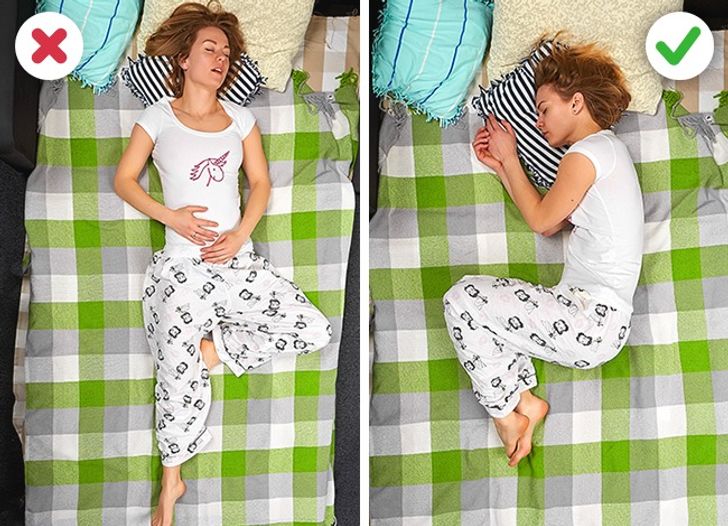
If you tend to snore, avoid sleeping on your back. In this position, the tissue in your throat sags, and your tongue falls backward into your throat, narrowing the airway.
Choose your pillow carefully. Overly soft pillows can cause your head to tilt backward and increase snoring. Use an extra pillow or elevate the head off your bed a few inches to stop your tongue from falling back over your windpipe.
Sleep on your side. With your head lying in a natural position, nothing will restrict the airflow.
Do special exercises. Exercising the muscles of your tongue and throat can help strengthen them and reduce snoring.
Leg cramps
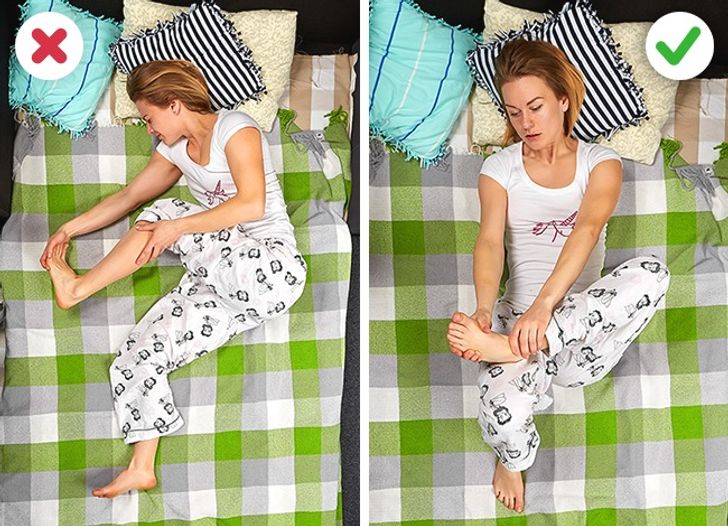
Leg cramps are usually sudden spasms or tightening of the muscles in the calf, feet, or thighs. Almost 80% of people suffer from this problem, regardless of age. Night leg cramps are most often related to some disease, nerve damage, or lack of trace elements. If you experience this condition too often, talk to your doctor.
One good way to stop leg cramps is to get the calf muscle stretched and strengthened. You can try doing yoga or massage your legs before bedtime. Just remember: if you want to achieve good results, you should exercise regularly.
Other problems
Sleep disorders can be caused by many factors, from fatigue and uncomfortable shoes to problems with the digestive or nervous system. Only a doctor can determine the cause of the problem and advise on the treatment.

If you suffer from frequent heartburn it’s a good idea to lie on your left side while catching some z’s. The left-side sleeping position prevents stomach contents from coming back up into the esophagus, preventing heartburn.
Do you have aching legs at night? Use a roll pillow or the foot of your bed to keep your legs lifted during sleep. The venous blood accumulated in your legs will run downward, and you’ll feel better. Also, try rubbing or lightly massaging your legs before retiring for the night, and avoid consuming caffeine at least 6 hours before bedtime.
Comments
These are very important information. worth to visit this site. keep going............. click on this
Gonna start using today
Related Reads
15+ Funny “Beware of the Dog” Signs and the Very Dangerous Dogs Behind Them

15+ Mothers-in-Law Who Can Turn an Ordinary Day Into a Comedy Show

I Refused to Follow My Mom’s “Different Beds” Rule—And the Real Reason Was Heartbreaking

My In-Laws Told Me Not to Share a Bed With My Wife—I Am Furious

I Discovered My Firm Was Secretly Hiring for My Position—HR’s Response Shocked Me

I’m Child-Free—And My Will Was the Plot Twist My Family Didn’t See Coming

My Dad Let Me Believe a Heartbreaking Story About My Mom, and I Refuse to Let Him Get Away With It

12 Moments When Stepparents Became Their Family’s Silent Heroes

My Sister Refused to Let Me Be in Her Wedding, and the Reason Shattered Me

15 True Stories With Mind-Blowing Endings That Could Rival Hollywood

My Coworker Reports Everyone to HR to Get Bonuses—So I Turned the Tables

I Adopted a Son—Then His Biological Family Shattered Our World
